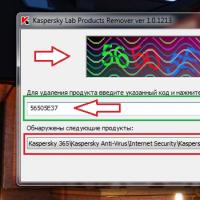Everything about wake on lan. Wake On Lan technology. First, let's configure the network card
Did you know that the computer can be turned on remotely via the lan network or even via the Internet. Wake-On-LAN technology has been around for quite some time, and now we will look at how it works.
Wake-On-LAN (sometimes abbreviated as WoL) is a standard protocol for waking computers remotely. Naturally, the computer must be physically connected to both electricity and a router using a wired or even Wi-Fi connection. The Wake-on-Wireless-LAN protocol allows you to turn on your computer without a wired network connection.
Enabling Wake-On-LAN depends on two things: the motherboard and the network card. Your motherboard must be connected to an ATX compatible power supply i.e. to almost any power supply that has been produced for 17 years already. The network card or wireless card must also support this function. Since the inclusion of the WoL protocol is set either through the BIOS or through the firmware of your network card. In the latter case, you will need special software to turn on the computer.
Wake-On-LAN support is a fairly common feature built into motherboards and network cards by default. Moreover, among the listed characteristics in stores, you will not find any mention of Wake-On-LAN support.
Magic Packet: How Wake-on-LAN Works
Wake-On-LAN turns on the computer by sending "magic packets" to its network card, which include the network broadcast address, broadcast address, MAC address of the network card, and a special sequence of bytes - a data packet. These magic packages are absolutely identical for any platform, be it Intel or AMD or Apple. Typical ports used for WoL and magic packets are UDP 7 and 9. Since every computer is actively listening to the data channel, such a magic packet, which has a unique computer identifier (MAC address of the network card), will be easily caught and processed.
The figure above shows the results of the packet sniffer. This raises a reasonable question: is the transfer of the magic packet safe? After all, it will not be difficult to intercept unprotected traffic. How secure is Wake-On-LAN transmission when used over insecure networks and over the Internet? On a secure network or in home use, there should be no cause for concern. And in an open network, it is better not to use Wake-On-LAN or at least take care of the connection profile of your network card, choosing at least options with a minimum openness of resources to the outside.
How to enable Wake-On-LAN
In order to start using Wake-On-LAN, there are several options for enabling it. The easiest one is through the motherboard BIOS. Another option is through a special utility from the manufacturer of your motherboard or network card.
In BIOS
Most older computers and many modern ones have their own Wake-On-LAN settings, hardcoded into the BIOS. In order to enter the BIOS, you need to click on the button DEL or F1 or F2 When you boot your computer, After entering BIOS, go to Power or Advanced Options.
 Award BIOS
Award BIOS
In the UEFI BIOS, the Wake-On-LAN enable setting is usually found in additional options, sometimes in the PCIE / PCI power on section.
Also, motherboard manufacturers call the technology differently: Aggresslive Link from ASRock, ErP from Gigabyte, PME from ASUS.
 UEFI BIOS
UEFI BIOS
In the Windows operating system
You can also enable Wake-On-LAN in the operating system. How to do it on Windows. Open the menu START and enter Device Manager... After opening Device Manager, expand the section Network adapters... Right click on the network card and select Properties then go to tab Additionally.

Scroll through the list and find Wake on magic packet, Wake on LAN- each manufacturer calls this setting in its own way. Change the value to Enabled if it is off.

Now go to the tab Power management, and make sure the option Allow the device to wake up the computer included. Additionally, you can check the box opposite Allow only magic package to wake up the computer.

On macOS
Open system preferences and select Energy saving... Check the option Wake for Network Access or something similar. This will enable Wake-on-LAN.

On Linux
Ubuntu has a great tool that can check if the network card supports Wake-on-LAN and can be enabled. Open a terminal and install ethtool using the following command:
Sudo apt-get install ethtool
And you can support Wake-on-LAN by running:
If your network interface is different eth1, eth2, eth3 and so on, replace it.

Find the item Wake-on... To enable this option, use the following command:
Sudo ethtool -s eth0 wol g
Run the command again to make sure it is enabled. Should be Wake-on: g.
How to turn on the computer using Wake-on-LAN
To send Wake-on-LAN requests, there are several options available:
Depicus for Windows, Apple and Android
Depicus has a great series of lightweight tools to get the job done, including a GUI for Windows and a command line for Windows and macOS. In addition, a separate application is available for Android, iPhone and Windows Mobile.
& nbsp & nbsp & nbsp The technology of turning on the power supply ("waking up") of the computer is part of the specification ACPI (Advanced Configuration and Power Interface), power management interface. It is sometimes also referred to as the interface for accessing energy-saving hardware functions. Remote computer activation is a small and far from the main part of this specification. Description of ACPI can be easily found on the Internet (description of ACPI 2.0 contains over 400 pages).The specification defines system states S1-S5 - "sleep states" in order of decreasing power consumption. S5 is the state of software shutdown (Soft OFF) - everything is turned off, except for those devices through which it is possible to turn on the computer. To power such devices, the standby voltage + 5V SB (+ 5V Standby) is used, generated by the computer's power supply in the off, but not de-energized state. To transition from one state S1-S4 to another (S2 to S1 for example), PME (Power Management Events) are used - power management events, most of which are caused by a hardware interrupt from a specific device.
& nbsp & nbsp & nbsp "Wake On Lan" technology ("Magic packet" technology) is used to turn on power to a remote computer in a "Soft Off" state by sending a specially crafted Ethernet frame to its network adapter.
& nbsp & nbsp The remote computer must meet certain requirements:
- Hardware must comply with ACPI specification and "Wake On Lan" support must be enabled in BIOS settings.
- Have an ATX power supply.
- Have a network card that supports "Wake On Lan" (WOL) technology.
& nbsp & nbsp & nbsp The network adapter on the turned off computer remains powered by + 5VSB of the power supply in the standby mode for receiving a special Ethernet frame, in the data field of which there is a sequence of 6 bytes FF and its own MAC address repeated 16 times. Having received such a packet, the adapter generates a signal to turn on the computer's power supply.
Below is the contents of the packet as captured by the traffic analyzer.
The destination address (the first 6 bytes of the frame field) is FFFFFFFFFFFF (Broadcast), the source address is 0015F20016CA (6 bytes after the destination address) The data field is highlighted in red in the hex dump area. The MAC address of the included computer is 00046175F9DA.
& nbsp & nbsp Almost all modern PCI network adapters and motherboards support this technology, but there are some subtleties. If the motherboard has PCI bus specifications up to 2.2 (most models based on Pentium II and Pentium III processors), then it must have a 3-pin "Wake On Lan" connector and the same connector must be on the network adapter. They need to be connected with a special cable supplied with the adapter. For the case with the PCI 2.2 bus, this connection has already been made directly. If you have a Pentium II or older computer, Wake On Lan should work.
& nbsp & nbsp & nbsp In the BIOS settings of modern motherboards, the term "Wake On Lan" is practically not used. Look for a similar value in the settings of the power management section ("Power Management Setup", or "ACPI Configuration", etc.), for example, "Wake-Up by PCI device", "Power on by Ethernet Card", etc. P.
Below is an example of settings for the "Power - APM Configuration" AMI BIOS v2.61 section:

To enable Wake On Lan mode, you must set the item "Power On By PCI Devices" to "Enabled".
Just in case, the meaning of the remaining options:
Restore on AC Power Loss- the behavior of the system in the event of a power failure. Value Power Off - the system will remain in the off state, Power On - the computer will be turned on as soon as the power supply is restored.
Power On By RTC Alarm- turning on the power supply according to the computer's internal clock (analogue of an alarm clock).
Power On By External Modems- power on will be performed when there is an incoming call to an external modem connected to the serial port.
Power On By PCIE Devices- allows turning on the computer from devices on the PCI-E bus. If your network card uses the PCI-E bus, and not PCI, then to enable the Wake On Lan mode, you need to set this option to "Enable".
Power On By PS / 2 Keyboard- allows switching on the power supply from the keyboard connected to the PS / 2 connector
& nbsp & nbsp & nbsp Well, and the last thing that is needed to turn on the power supply of the computer through the local network is a program that generates a WOL - packet (Magic Packet). It is easy to find it on the net. One of the options - broadc.exe- utility for turning on a computer over a local network. (download, 32kb)
Command line format:
broadc.exe Network card MAC address 255.255.255.255 67
& nbsp & nbsp Usage examples:
bbroadc.exe 0002b3d8b4e6 255.255.255.255 67- turn on the computer, the MAC - address of the network card of which is 0002b3d8b4e6.
Option for Linux - wakeonlan- (download, ~ 5kb)
By default, the program uses a broadcast address and a UDP packet to port 9 (discadrd) to send the Magic Packet "a. Therefore, inside the local network, to turn on the computer, it is enough to set the MAC address of the network card in the form 00: 01: 02: 03: 04: 05
Command line format:
wakeonlan MAC address
& nbsp & nbsp Examples of remotely turning on and off the computer at the right time can be found in the section Windows Automation with nncron Lite.
& nbsp & nbsp This technology can be used not only on the local network, but also on the Internet, you just need to take into account the fact that the generated Magic Packet will pass through the routers, that is, it must contain the correct IP and MAC addresses. The Broadc.exe program mentioned above does not allow generating the destination MAC address in the Ethernet frame header other than FFFFFFFFFFFF (Broadcast), therefore such a packet will not reach the receiver (remotely connected computer), since routers block broadcast packets. To form a Magic Packet, which enables a computer to be switched on remotely in a foreign network, you can use the utility wol.exe- (download, ~ 5kb). At a smaller size than broadc.exe, the program has slightly more features. In command line parameters, you can specify the name of a text file that contains a list of MAC addresses of computers to be turned on remotely. Content example:
# maclist - mac addresses for wakonlan & nbsp & nbsp - a line starting with # is not processed - this is a comment
00: BA: BE: FA: CE: 00 PC1 & nbsp & nbsp - Enable by MAC address
00: 11: 22: 33: 44: 5A PC2
195.210.128.3-01: 12: 23: 34: 45: 67 SERVER.COM & nbsp & nbsp - Enable over IP plus MAC
0xC0A801F0-12: 23: 34: 45: 56: 67 HOST.RU & nbsp & nbsp - The same as before. case, but IP is in hexadecimal.
By default, the program generates a UDP packet on port 60000. The port number can be changed. Examples:
wol.exe 01: 02: 03: 04: 05: 06:
wol.exe 212.248.111.222-00: 00: 00: 00: 00: 99
wol.exe -p = 4096 212.248.111.222-00: 00: 00: 00: 00: 99
Please note that the IP address in the startup parameters is not the IP address of the computer being turned on, and the address of an included and available node that ensures the transmission of the packet to the final recipient, i.e. turned off computer. The turned off computer has no drivers loaded and its IP address cannot be associated with the MAC address (ARP protocol) - wol will fail with an IP resolution error. A fairly common reason that Wake On Lan "does not work" is the use of the IP address of the computer to be turned on in the parameters of programs to enable.
& nbsp & nbsp This utility (wol.exe) I successfully used to turn on the computer in the Stream network. The router through which the computer connects to the Internet is configured in such a way that the packet generated by the wol.exe utility and arriving at a specific port (for example 4009) is sent to the local network with a broadcast MAC address. Typically, a network card only accepts frames whose destination address matches the hardware address of the interface (its own MAC address) or the broadcast address (address FFFFFFFFFFFF). In the settings of the Zyxel P660RU2 ADSL modem (Network-NAT-Port Forwarding), a rule is created to redirect the received packet to the broadcast address 192.168.1.255:

Start command:
Wol.exe -p = 4009 & ltIP of ADSL modem & gt- & ltMAC address of the computer's network card & gt
For example:
wol.exe -p = 4009 85.140.21.22-00: 00: A0: 80: 87: 99
& nbsp & nbsp And one more thing - remote power-on does not work if the computer was completely de-energized, for example, when ~ 220V is lost. In such cases, to ensure its self-activation, you can use the BIOS mode setting in the "Power Management Setup" section - "Power on after power fail" or similar in meaning ("After AC Power Lost" - "POWER ON" - the name depends on the BIOS version and manufacturer). After the appearance of ~ 220V, the computer should turn on by itself, without pressing the "Power" button.
& nbsp & nbsp The practice of using Wake On Lan revealed another point - some computers, when enabling the network wake-up mode in the BIOS settings, turn on the power on their own, without even receiving a frame with a Magic Packet. The reason for this phenomenon is that some network cards (noticed by Intel, 3COM) to turn on the power supply over the local network, they use not only WOL, but also other events (Wake on ARP, Wake on Link Change, etc.), moreover, by default, several activation criteria are used at once. remove unnecessary conditions from the adapter settings (as a rule, using a special utility), and everything will work correctly.
& nbsp & nbsp Example, for Intel (R) PRO / 100VE network adapter. Using the Intel (R) PROSet II utility (supplied with the adapter), uncheck all events except "Wake on Magic Packet":

After saving the settings, your computer will only turn on when you receive the Magic Packet "a.
& nbsp & nbsp Sometimes, enabling the remote power-on mode over the local network in the BIOS settings is not enough. This is usually due to the characteristics of a particular type of network adapter. I will explain it using the example of a network card based on the Atheros chipset (controller AR8121 / AR8113 / AR8114 PCI-E Ethernet Adapter). After setting the mode Power On by PCI-E Device in the BIOS settings of the motherboard, the computer does not power on remotely. In the properties of the network connection for this adapter there is a button Tune

There is a tab in the properties of the network controller Additionally.

& nbsp & nbsp In this window, you can view or change some parameters and operating modes of the selected network card. In particular, by default, the modes Wake up after shutdown and Awakening possibilities installed in Not... It is for this reason that the remote power-on is not performed. After setting the resolution, wake up mode and frame type Magic Packet everything should work as expected.
& nbsp & nbsp For those who need software with a graphical user interface, I can recommend a miniature and very easy-to-use utility - (download, ~ 78kb).

Determining the MAC address of the network card.
& nbsp & nbsp & nbsp In LINUX, you can use the arping utility for these purposes:
Arping & lt IP address & gt
For example:
arping 192.168.0.1
& nbsp & nbsp On Windows, you can use the arp command to display the contents of the ARP cache on the screen. To make kzsh relevant for the required IP address, before the command arp can be done ping, i.e. execute sequentially:
Ping & lt IP & GT
arp -a
& nbsp for example:
ping 192.168.0.1
arp -a
By the way, you can use the same method in LINUX.
& nbsp & nbsp Own The MAC address can be determined using the commands:
In LINUX
ifconfig & LT interface & GT& nbsp & nbsp for example - ifconfig eth0
On Windows
ipconfig / all
In Windows XP and higher, you can use the console command to get the MAC address of your network card getmac.exe
Few Windows users have heard of Wake-On-Lan (or WOL for short), much less have ever used it. Most of the readers of our site already yawn at this phrase, and will hasten to switch their attention to something else, more understandable and interesting to read. But do not rush to do this, because WOL technology, in fact, is quite clear, simple and in demand at the present time.
Let's consider in stages what Wake-On-Lan technology is, what requirements this technology has for computer components, what are the features of its settings in Windows 10, and also in what cases it may be needed, when and how it can be applied in everyday life.
What is Wake-ON-LAN?
WOL, invented and introduced into the functionality of network devices a long time ago, but not too initially in demand (only in narrow circles - network business solutions) Wake-On-LAN allows you to turn on a PC remotely by sending a special command via a local network, or even via the Internet ... It immediately becomes clear that this is a convenient function - to "wake up" your "machine" remotely in order to gain access to your files, operating system and software installed in the OS.
Thus, using the Wake-On-Lan + bundle (TeamViewer, Radmin, and others), anyone can control their PC, work in it, configure its components from anywhere in the world, accessing the PC via the Internet. At the same time, no help, the presence of anyone else directly near the computer is required.
Also, in a nutshell, it is worth noting that on the basis of WOL it is possible to implement Wake-on-Wireless LAN - this is a technology for wirelessly turning on a computer, based on the operation of WiFi routers and other similar devices. Of course, such devices for wireless data transmission should include support for remote activation in their software and hardware functionality.
WOL technology requirements
To implement such a PC operation scheme, the following technical conditions must be observed:
- The PC motherboard (in which, as a rule, the network card is integrated) must have a built-in Wake-On-Lan support function. Let's reassure you right away - in modern motherboards such a function is always present, i.e. there is almost by default.
- The PC power supply must support the well-known ATX standard. This technology is more than 1.5 decades old, it is popular and used and the ATX standard is supported by almost all power supplies available on the computer accessories market.
- The computer itself must be constantly connected to a power source - whether it is an electrical outlet, a battery (if it is a laptop or another type of laptop PC), or an uninterruptible power supply (UPS).
Due to the fact that the work of the WOL technology is implemented at the hardware level of the computer, this technology works in most types of operating systems, be it Windows, Mac or Linux.
The convenience of Wake-On-Lan technology lies in the fact that when the computer is not in demand by you (and you are remote from the computer), the PC can be in any of the operating states that save energy. Be it hibernation mode, hibernation mode, whatever - the PC can even be turned off (but, of course, not physically disconnected from the power supply)! Well, in case you need any files on this PC, or you need to run a certain program on it, you can easily “wake up” your computer, turn it on remotely and start working with it. And this, you see, is very convenient, very effective.
So, if the technical conditions are met, the WOL standards and format are supported, let's go to the Wake-On-Lan settings section to implement this functionality.
Configuring and enabling Wake-On-Lan in Windows 10
Being directly in Windows 10, we press the combination of keyboard buttons “WIN” + “I”, the “Settings” window will open, in it select the “Network and Internet” section:
In the window that appears, click on the “Ehernet” (network adapter) section on the right side of the window, and then on the left side of the window, click on the “Configure adapter parameters” item:
The "Network Connections" window will open. Find the shortcut with the name “Ethernet”, right-click on it, and select “Properties” from the pop-up menu:
The settings of the PC network card will open. At the top right, immediately under the name of the network card, click on the "Configure" button.
In the window that opens, select the "Advanced" tab with the mouse. Further, in the appeared window of network card properties settings - scroll through the list of parameters to the item “Wake on Magic Packet”, select it with a mouse click, and in the right part of the window switch the parameter in the “Enabled” state, if the state is “Disabled” - "turned off":
Further, without clicking the "Ok" button, and without closing the current window - select the "Power Management" tab. In this window, check the checkboxes on the items (enable them): 
After completing all these actions, click the "Ok" button, the settings window will close, the new parameters have taken effect from that moment. Close all other windows open for making these WOL settings.
"Magic" Wake-On-Lan package
As you may have noticed, in the previous section the term “magic” package was mentioned, it is also called “magic” package. What are we talking about in this case, what kind of magic, if the essence of the topic is purely technical - setting up a PC?
The fact is that the very same command transmitted over the network, which makes the computer “wake up”, turn on at the “order” of the owner, was called a “magic” packet.
What does a "magic" package look like? Everything is quite simple - it is a simple combination of numbers, a kind of numerical block that is sent over the network from the user's device to his remote computer in sleep mode. This block consists of the following parts:
- hexadecimal code “0xFF” repeated 6 times in a row;
- The MAC address of the computer's network card, repeated 16 times.
Due to the fact that the MAC address of any network device in the world is unique and does not repeat itself, the “magic” packet containing this MAC address can be intended for a very specific, one, network device. That allows you to remotely, being anywhere in the world, and having access to the Internet - to address exactly your device. All other PCs, routers and other network devices - accordingly, will not react in any way to the appearance of such a data packet, tk. they already have their own, also absolutely unique, MAC addresses.
The network adapter, thanks to the enabled Wake-On-Lan technology, constantly scans the network for the appearance of just this command in order to initiate the process of turning on the personal computer at the same instant - power will be supplied, the PC will turn on, and the Windows operating system will start up.
For all this, you need to put the network card into the PC power management mode, that is, allowing it to turn on the computer when a signal appears - a "magic" packet, which we did in the previous section.
Setting up the remote wake-up mode of the computer in the BIOS
For the successful operation of the computer in Wake-On-Lan mode, in addition to complying with the technical requirements of the supported standards, and the corresponding setting of the network card, you must also enable the corresponding operating mode in the computer BIOS.
Restart (turn on) the computer, and from the first seconds of the boot start press the “F2” or “DEL” key continuously, depending on the BIOS version. Next, we need to find the appropriate BIOS setting that allows you to enable Wake-On-Lan mode. Typically, this option is found under the BIOS “Configuration” or “Power management”. But due to the fact that there are quite a lot of BIOS versions on the personal computer market, and they differ greatly among themselves in terms of interface design, it is a difficult task to write unequivocally where the WOL option is located.
Even the name of the remote enable technology itself can be called differently, depending on the model and BIOS version, PC platform (MAC, Windows, Linux). In addition to the original name “Wake-On-Lan”, see examples of possible alternative names from the list:
After the option is found, select the option for its mode of operation as “Enabled” or “Enabled” if the BIOS is in English. That's it, the BIOS settings are now complete. To save the changes, press the “F10” key, or in the BIOS menu item, find the “Save and exit” item, confirm the correct choice of the exit option (with saving) in the window that opens by clicking OK. The computer will reboot with the new BIOS parameter set.
Security and Wake-ON-LAN
The essence of the WOL technology is such that each of the users of the local (global) network in which the computer itself with WOL enabled is located can start this computer, knowing the MAC address of the PC's network card. Accordingly, the issue of data security remains open.
The problem is relevant only for computers with the included wake-up technology, which are connected to any public network. For computers on a home network - the level of security is at a high level.
On the other hand, even after turning on a remote PC by sending it a "magic" packet, an attacker will not be able to bypass the PC's security settings. The password for logging into the account, the password when starting the BIOS (if this option is set), personal firewall security settings inside Windows and other security-related issues - the attacker will have to somehow bypass, because the Wake-ON-Lan technology allows just turn on the computer remotely, but does not give direct access to information on the computer.
There have been cases when hackers, using a bunch of server technologies such as PXE and DHCP, still got access to the Windows operating system on a remote PC, using a Windows installation image to bypass protection, specially configured for themselves, for their own selfish purposes ... But this is the lot of a narrow circle of IT specialists with a high level of knowledge, who are unlikely to use a regular home PC for an ordinary user.
To summarize. Practical use of Wake-ON-LAN
So, we learned what the technology of remote turning on of a computer called Wake-ON-Lan is. The technology itself is not new. But despite this, it has more and more options for use - not only in any business solutions using extensive local networks, managed servers operating on various network technologies, etc., but WOL can already be applied in everyday, home life, or within the tasks of a small office.
As an example, you can use WOL to create a technological eco-space “smart home”. Indeed, it is a very laconic, competent, and convenient solution. You do not need to purchase anything additional from hardware or software to organize a local server with remote access at your home, which you can already control home devices, get statistics on their work, etc.
Do you use this PC function in your life, work? Share your experience and impressions of using Wake-ON-Lan technology in the comments below this article!
Let's say you have remote computers on your local network, to which you periodically connect from your computer via remote desktop or using special programs Team Viewer or Radmin, it doesn't matter. And to connect, you do not need the remote computer to be turned on, but if it is turned off and you are far away or too lazy to go to turn it on, press the power button. This is where WOL technology comes to the rescue, which stands for Wake On Lan, which translates as "wake up over the network." What does this technology do ?, it sends a "magic packet", so to speak, this packet carries data with a certain sequence.
Requirements for a remote computer for this technology to work is:
- Motherboard powered by ATX;
- BIOS here you need to enable Wake-On-LAN support, and configure power saving correctly.
- LAN card with support for WOL technology (also almost everything, but it still needs to be enabled in the settings of the network card);
And so we made sure that we have a motherboard with ATX power supply, these are almost all modern computers.
We go into BIOS, find in the menu something similar to Power Management Setup or in Advanced. We turn on the Wake-On-LAN function, this item looks different depending on the BIOS, for example:
- Resume by LAN
- Wake up on lan
- WOL From Soft-Off
- Power Up on PCI
 In general, see everything about the phrases "Power Up", "WOL", "Wake Up", "Resume by" but related to LAN, MAC or PCI.
In general, see everything about the phrases "Power Up", "WOL", "Wake Up", "Resume by" but related to LAN, MAC or PCI.
We transfer the operation of the motherboard to a certain power saving mode Suspend Mode, mainly computers support ACPI and only allow two modes S1 (POS) and S3 (STR), but we will be interested in S1 (Power on Suspend) mode, this is also very important, otherwise on our the network card will not be continuously supplied with 5V when the computer is off, and we will not be able to turn it on.
After turning on the setting in the BIOS, you need to make sure that when the computer is off, the green or orange indicator on the network card is on, which will mean that everything has been done correctly.
- Wake on magic packet
- Wake on pattern
- Wake on lan
- WakeOnLan from PowerOff
- Wake from shutdown
If any settings were not found, then you will have to read the documentation for your network card or motherboard yourself and find out which items this all includes, but they are definitely there and must be included, otherwise nothing will work.
And after you have set up both the BIOS and the Network Card, turn off the computer and look and once again make sure that the green light on the back of the network card is on, it should be on, thereby indicating that it is ready to receive a magic packet.
Remote turn-on of a computer via a local network
In this case, it is not necessary to know the IP address of the computer. It is enough to send a broadcast packet 225.225.225.225 to the local network.
- You need to know the MAC address (physical address) of the network card of the computer you are going to turn on.
- You need a program that will send this magic packet (_http: //www.depicus.com/wake-on-lan/wake-on-lan-gui.aspx).
Turning on a computer remotely via the Internet
- You need to know the white IP address of the remote computer to be turned on;
- MAC address;
- If at the other end the remote computer is in a local network under the control of a server or router, then you need to configure them by forwarding ports to the included computer in this network.
Let's say your white IP is 109.xxx.xx. 112, then you need to register in the router in the section “Forwarding one port” an External port, for example 4545 (or another unused one), and Internal port 3389 (RDP port, only this is required), To the IP address 192.168.1.123 of the included computer.
PS: It is very important when connecting remotely via a local network or via the Internet, do not forget to check the ports for availability (openness), especially external, otherwise your magic package will be denied access, you can check using the service _http: //2ip.ru/check-port /. If the port is closed, then it is blocked by the Firewall (Firewall) on the router or server. It needs to be opened.
Wake on LAN (WOL) is a technology that allows you to remotely turn on a computer via a local network or over the Internet. (Link to Wikipedia:https://ru.wikipedia.org/wiki/Wake-on-LAN )
Program for enabling Wake on LAN: http://www.syslab.ru/wakeon
To use the "Wake On Lan" technology ("Magic packet" technology) there must be:
1. Hardware must comply with ACPI specification and support for "Wake On Lan" mode must be enabled in BIOS settings.
2. Have an ATX power supply.
3. Have a network card that supports "Wake On Lan" (WOL) technology.
4. Configure Wake on LAN via Router. (setup examples)
Customization
1. Turn on WOL in BIOS
You can determine if your computer's motherboard supports Wake On Lan. by going to CMOS Setup in the power management settings section. Find the option there "Wake On Lan" and make sure it is turned on.
Example: "Power - APM Configuration" AMI BIOS v2.61:
To enable Wake On Lan mode, set the "Power On By PCI Devices" item to "Enabled"
2. Customization linux for Wake on lan
- We putpackageethtool (apt-get install ethtool)
- Checking if the card supports "Supports Wake-On"
ethtool eth0 | grep –i wake-on
In line Supports Wake-On the mechanisms supported by the network card are listed. In my example, I use the so-called send method. Magic Packet and if you want the same, then make sure in Supports Wake On there is a letter "G"... Letter "D" in line Wake-on means that Wake On Lan is disabled for this network interface. To enable it in the Magic Packet recognition mode, you must:
ethtool - s eth 0 wol g
-
approx ifconfig eth0 | grep –i hwaddr
Customization Windows forWake on lan
- Press the Start key and select "Computer Management" in the search box. Find your network adapter from the list of devices. Right-click on it from the Properties menu, and then find the Advanced tab. Scroll down the list and find the next item “Wake on Magic Packet” or something like that, and set the value to “Enabled”. Click on the OK button when done.
- You will also need to know the mac address of the network card ipconfig - all
- The practice of using Wake On Lan revealed one more thing - some computers, when enabling the network wake-up mode in the BIOS settings, turn on the power on their own, without even receiving a frame with a Magic Packet. The reason for this phenomenon is that some network cards (noticed from Intel, 3COM) to turn on the power supply over the local network, not only WOL is used, but also other events (Wake on ARP, Wake on Link Change, etc.), moreover, by default, several activation criteria are involved at once. adapter settings (usually using a special utility) unnecessary conditions, and everything will work correctly.
Customization MACOS for Wake on lan
Open the System Settings window and select Energy Saver. On the Options tab, you should see the phrase "Wake up from Ethernet" or something similar. This option enables the Wake-on-LAN feature.
Customization FreeBSD forWake on lan
With each release of FreeBSD, more and more network card drivers are getting Wake-on-LAN support.
http://forums.freebsd.org/threads/wake-on-lan.28730/ (here it is discussed how to slip the driver)
3.Routers:
a.ZyXEL:WakeonLAN Via Internet Center SeriesKeenetic(http: // zyxel .ru / kb / 2122)
b.Example for configuring a routerTP-Link:
1. come in in section Forwarding-> Virtual Servers
2. will add "virtual server" specify its IP address and port that will be used to enable. Typically ports 7 and 9 are used for Wake-On-LAN, but you can also specify any other port (1 to 65535). Set the protocol type to UDP or ALL.
3. Go IP & MAC Binding-> Binding Settings Enable option Arp binding .
4. Add a new entry for the computer that you will remotely turn on by specifying its IP and MAC addresses. Do not forget to enable the option for it too. Bind.
c.Example for configuring a routermikrotik:
Note: Bmikrotik has a built-in utilitytoolwol which allows you to turn on the computer directly from the router. (http://wiki.mikrotik.com/wiki/%D0%A0%D1%83%D0%BA%D0%BE%D0%B2%D0%BE%D0%B4%D1%81%D1%82%D0 % B2% D0% B0:% D0% 98% D0% BD% D1% 81% D1% 82% D1% 80% D1% 83% D0% BC% D0% B5% D0% BD% D1% 82% D1% 8B_ (Tools) / Wake-on-LAN )
An example of setting up a microtic to turn on the computer throughsyslab:
1. Create a static entry in the ARP table for broadcast
> / ip arp add address = 192.168.1.254 disabled = no interface = bridge-local mac-address = FF: FF: FF: FF: FF: FF
2. Create a static entry in the ARP table for the user's computer
 The best programs for reading and editing: do without Photoshop psd extension than open
The best programs for reading and editing: do without Photoshop psd extension than open Why is my phone charging slowly?
Why is my phone charging slowly? How to add a folder to an exception in Kaspersky How to add exceptions to a program in Kaspersky
How to add a folder to an exception in Kaspersky How to add exceptions to a program in Kaspersky Installing Kaspersky Security Center Installing the Administration Server kaspersky security center 10
Installing Kaspersky Security Center Installing the Administration Server kaspersky security center 10 How to take a screenshot on a computer: All possible ways How to take a screenshot of a photo
How to take a screenshot on a computer: All possible ways How to take a screenshot of a photo Screenshot - what is it and how to make a screen Ways to take a screenshot on a computer
Screenshot - what is it and how to make a screen Ways to take a screenshot on a computer Free renewal of the Kaspersky Anti-Virus license Suspension of protection from Kaspersky Gadget
Free renewal of the Kaspersky Anti-Virus license Suspension of protection from Kaspersky Gadget